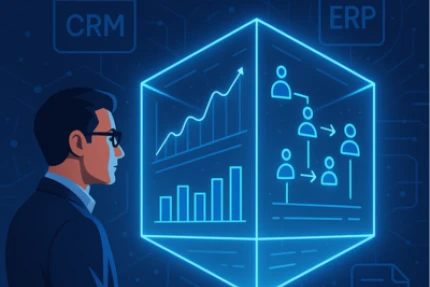
Recurring revenue is the financial backbone of any B2B SaaS company. Yet many finance teams still lack clarity around accurately calculating and segmenting the two most critical metrics in SaaS: ARR (Annual Recurring Revenue) and MRR (Monthly Recurring Revenue).
When tracked properly, along with GRR, NRR, and Renewal Rate these metrics unlock insights that guide forecasting, improve board reporting, and inform strategic decision-making. When tracked poorly, they can lead to inconsistent reporting, flawed projections, and missed opportunities.
This guide breaks down what ARR and MRR really mean, how to calculate them correctly, and how CFOs can use them to drive stronger financial and operational outcomes.
What Are ARR and MRR?
Annual Recurring Revenue (ARR) represents the predictable, contracted revenue your business expects to earn over a 12-month period from subscriptions.
Monthly Recurring Revenue (MRR) is the same concept but normalized on a monthly basis.
These metrics exclude non-recurring revenue such as onboarding fees, professional services, hardware, or one-time add-ons. Their purpose is to isolate the recurring component of your business, which is what drives predictability, growth, and ultimately valuation.
How to Track ARR and MRR Correctly
Getting ARR and MRR right requires both discipline and precision. Here are best practices:
Normalize Contract Terms
- Convert all customer contracts to a consistent time basis—monthly for MRR, annually for ARR.
- Separate month-to-month contracts from multi-year deals to avoid distorting renewal and churn calculations.
Segment Recurring Revenue
Break out revenue by type for a more actionable view:
- New Logo ARR: First-time subscriptions from new customers
- Expansion ARR: Upsells, product cross-sells, or price increases
- Downgrade ARR: Unit decreases, product contractions, or price decreases
- Churned ARR: Revenue lost from customer cancellations
- Reactivation ARR: Revenue from returning customers within a certain timeframe
Track by Product and ICP
- Group ARR and MRR by product line or pricing tier (e.g., Good, Better, Best).
- Slice ARR, GRR, NRR, Average ARR by customer segments. This would allow you to identify white space for cross-sell and contribute to account scoring.
Exclude Non-Recurring Revenue
Do not include services revenue, hardware sales, or implementation fees. These may contribute to total revenue, but they do not belong in ARR or MRR calculations.
Use Cases for CFOs
ARR and MRR are not simply financial metrics. They are decision-making tools that can impact nearly every function in the business.
Forecasting and Planning
Segmented ARR enables precise revenue forecasting by contract type, customer cohort, or product. MRR provides month-over-month visibility, useful for shorter-term operational planning.
Manage Renewals
By seeing clearly what’s Available to Renew and track how much has been renewed—Renewal Rate, companies can reduce churn through discipline.
Valuation and Investor Reporting
ARR growth is a central valuation metric for SaaS companies. Clean, segmented ARR supported by retention metrics like GRR (Gross Revenue Retention) and NRR (Net Revenue Retention) improves investor confidence in revenue quality of a company and board transparency.
Unit Economics
When ARR and MRR are layered with CAC (Customer Acquisition Cost), you can calculate CAC payback, LTV (Customer Lifetime Value), and contribution margin. These are critical for evaluating go-to-market efficiency and cash burn.
Churn and Risk Analysis
By segmenting ARR by customer cohort or industry, CFOs can identify at-risk revenue and adjust retention strategies accordingly. This level of granularity supports early detection of churn signals.
Scenario Modeling
MRR allows you to model growth under different scenarios—new bookings targets, churn shocks, or pricing changes—and see the impact at the revenue level in real time.
Common Pitfalls to Avoid
Even experienced SaaS finance teams make avoidable mistakes:
- Spreadsheets are a good start, but are manual, time consuming, can contain many inconsistencies, and are not real-time
- Not adjusting for discounts, credits, free periods, or late renewals in a consistent manner
- Failing to reconcile ARR with opportunity close won, invoicing and revenue recognition schedules
- Using inconsistent logic for calculating expansion and downgrades across product lines
These issues can create material discrepancies in financial reporting, investor updates, and budgeting exercises.
How Discern Helps Finance Leaders Manage ARR and MRR
Discern provides a more reliable way to track, visualize, and report on recurring revenue:
- Real-time dashboards for ARR and MRR by product, pricing plan, region, and ICP
- Retention metrics (GRR, NRR, CARR) that are dynamically tied to actual contract data and opportunities
- Forecasting models that integrate churn, renewals, and expansion trends
- Revenue insights that connect subscription growth with cash flow, margin, and efficiency metrics
The goal isn’t just accurate reporting—it’s decision-ready data that helps finance leaders guide their business forward.
For SaaS CFOs, clean ARR and MRR metrics are non-negotiable. These numbers inform how you communicate with your board, how you plan for growth, and how you benchmark performance. Done right, they provide a powerful foundation for financial clarity, operational insight, and investor alignment.
Interested in improving the way you track and report recurring revenue?
Book a demo with Discern to see how we help finance teams turn recurring revenue into actionable insight.



